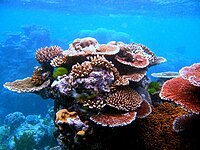
Photo from wikipedia
Understanding the response of coral growth to natural variation in the environment, as well as to acute temperature stress under current and future climate change conditions, is critical to predicting… Click to show full abstract
Understanding the response of coral growth to natural variation in the environment, as well as to acute temperature stress under current and future climate change conditions, is critical to predicting the future health of coral reef ecosystems. As such, ecological surveys are beginning to focus on corals that live in high thermal stress environments to understand how future coral populations may adapt to climate change. We investigated the relationship between coral growth, thermal microhabitat, symbionts type, and thermal acclimatization of four species of the Acropora hyacinthus complex in back-reef lagoons in American Samoa. Coral growth was measured from August 2010 to April 2016 using horizontal planar area of coral colonies derived from photographs and in situ maximum width measurements. Despite marked intraspecific variation, we found that planar colony growth rates were significantly different among cryptic species. The highly heat tolerant A. hyacinthus variant “HE” increased in area an average of 2.9% month−1 (0.03 cm average mean radial extension month−1). By contrast, the three less tolerant species averaged 6.1% (0.07 cm average mean radial extension month−1). Planar growth rates were 40% higher on average in corals harboring Clade C versus Clade D symbiont types, although marked inter-colony variation in growth rendered this difference nonsignificant. Planar growth rates for all four species dropped to near zero following a 2015 bleaching event, independent of the visually estimated percent area of bleaching. Within 1 yr, growth rates recovered to previous levels, confirming previous studies that found sublethal effects of thermal stress on coral growth. Long-term studies of individual coral colonies provide an important tool to measure impacts of environmental change and allow integration of coral physiology, genetics, symbionts, and microclimate on reef growth patterns.
Journal Title: Coral Reefs
Year Published: 2018
Link to full text (if available)
Share on Social Media: Sign Up to like & get
recommendations!